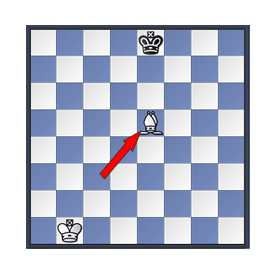When it is your turn to move you may move the various pieces to squares shown by  in the diagrams of the second section of this site. You may 'take' or 'capture' any piece that lies on a square in the path of movement of any of the pieces but a Pawn. (The Pawn does not 'take' along the same line as it moves - it is therefore dealt with in a separate section). in the diagrams of the second section of this site. You may 'take' or 'capture' any piece that lies on a square in the path of movement of any of the pieces but a Pawn. (The Pawn does not 'take' along the same line as it moves - it is therefore dealt with in a separate section).
By moving to a square from which you can 'take' a piece on your next go, you 'threaten' that piece or move into an attack position.. |
The White Bishop threatens all of the starred squares shown in the diagram.
It is said that the Bishop ATTACKS these squares.
|
 |
Suppose White wishes to move the Bishop to the square shown by the arrow?
It may move there of course!
|
 |
But what if any enemy piece already occupies that square?
Look at the attack pattern of the Bishop. Some of the stars have been removed .The knight blocks the path of the Bishop, and therefore removes some of the attack potential.
But it can capture the enemy piece and take its position on that square (that is why I have put a star on it!).
Captured pieces are removed from the board for the rest of the game. |
 |
The red squares are now no longer attacked by the Bishop, but the square with the Knight on it is being attacked. The White Bishop is ATTACKING the Black Knight and MAY capture it if it is White's turn to move. |
 |
As it is White's turn to move we will capture the Black Knight. |
 |
The Bishop moves and CAPTURES the Knight and stands in its place.The captured Knight is removed from the board for the rest of the game. |
 |
The White Knight ATTACKS the squares marked with a white star. |
 |
Suppose White wishes to move his Knight as shown and suppose there is an ENEMY piece there already? |
 |
Yes-a Bishop. The knight is therefore attacking the Bishop. It is White's turn to move. |
 |
White decides to take the Bishop. The Bishop is CAPTURED andthe White Knight takes its place. The captured Bishop is taken off the board. |
 |
Here is another example this time the Black Queen is situated on the KING SIDE edge of the board and attacks the squares marked with a black star. |
 |
We will suppose that there is a White Knight on a square as shown. You will see that the squares shaded red are no longer attacked by the Queen as the Knight has blocked the way. The Black Queen attacks the White Knight. |
 |
It is Black's turn to move. |
 |
The Black Queen CAPTURES the ENEMY knight and stands in its place. The Knight is removed from the board. |
 |
Every chess piece including the King , may make captures on the chessboard. Pawns have a special attacking and capturing move. They can only capture by moving one square diagonally. See next section.
- If you capture a Queen, it is worth 9 Pawns
- If you capture a Rook it is worth 5 Pawns
- If you capture a Bishop it is worth 3 Pawns
- If you Capture a Knight it is worth 3 Pawns
This tells you when pieces are captured how much you have won or lost.
It should be noted that this is only a rough guide to the value of the various pieces. Sometimes in a game a Knight or even a Pawn may be more valuable than a Queen. We will discuss this later. |




















 DISCLAIMER: The information given in this site is presented in good faith, but the site-author is human and does make mistakes! Should you find anything that you believe is in error please notify the Webmaster of your finding.
DISCLAIMER: The information given in this site is presented in good faith, but the site-author is human and does make mistakes! Should you find anything that you believe is in error please notify the Webmaster of your finding.